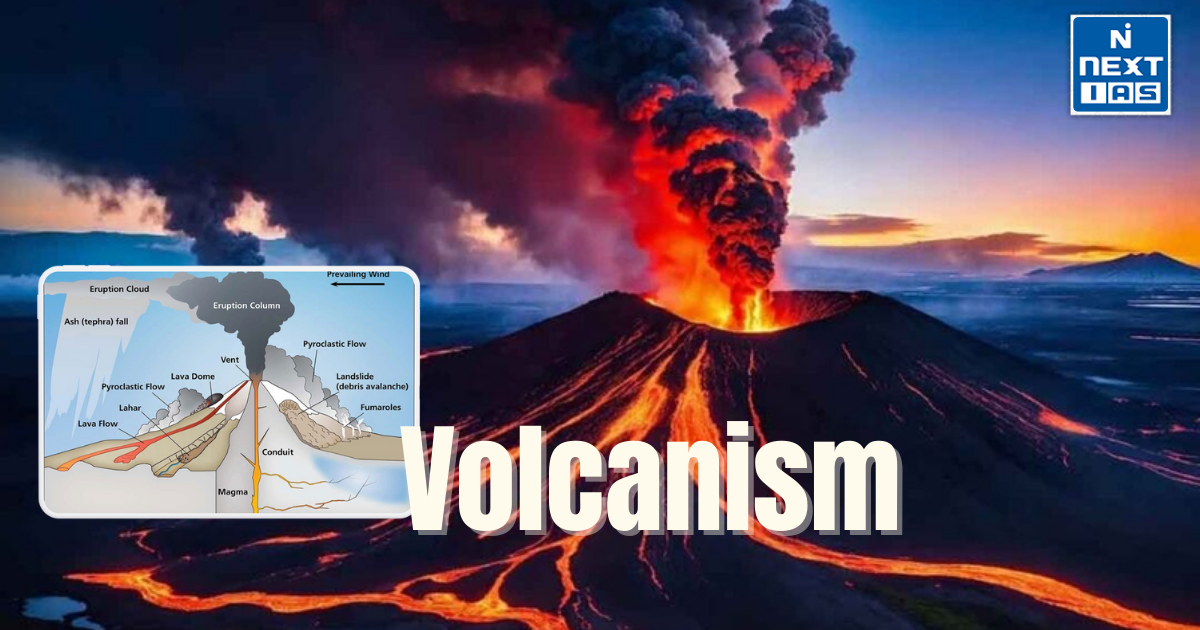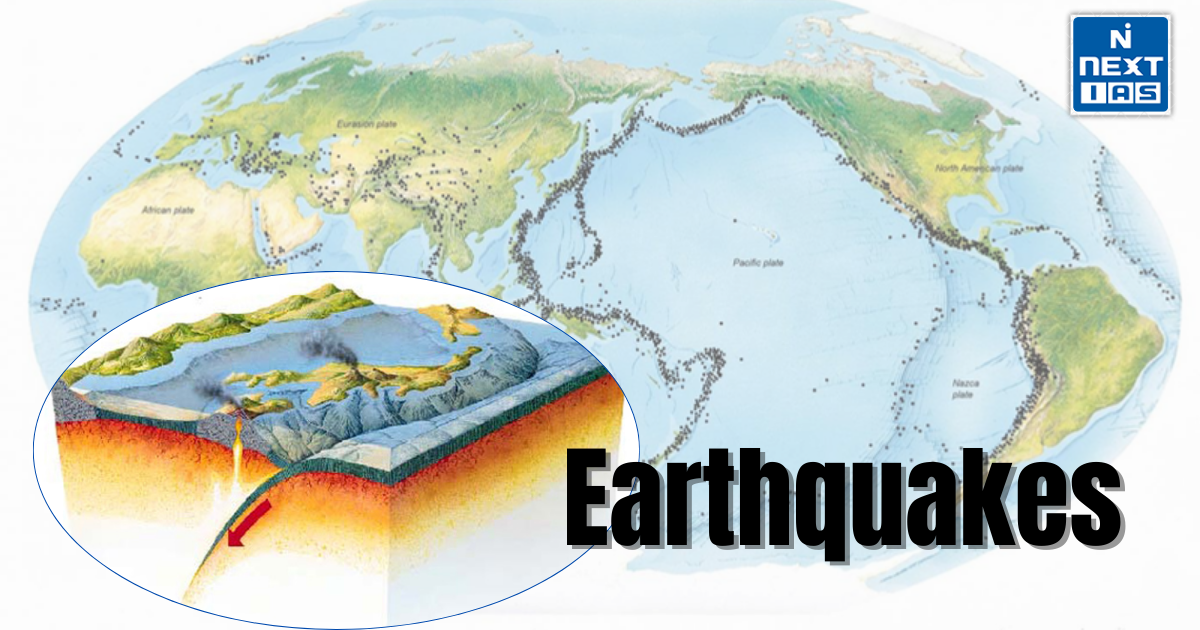
The Earth’s interior is a dynamic and layered structure that profoundly influences our planet’s geology and life. Comprising the crust, mantle, and core, these layers interact to drive processes like plate tectonics, volcanic activity, and Earth’s magnetic field, shaping the surface and sustaining the Earth’s geodynamic and thermal balance.
About The Interior of Earth
- The Earth’s interior is a complex, layered structure composed of the crust, mantle, and core, each with distinct properties and functions.
- The outermost layer, the crust, is thin and solid, forming the Earth’s surface where life exists. Beneath it lies the mantle, a vast, semi-solid layer of silicate minerals that extends to about 2,900 kilometers deep. The mantle’s convection currents drive plate tectonics, causing earthquakes, volcanic eruptions, and mountain formation.
- At the Earth’s center lies the core, divided into the liquid outer core and the solid inner core. The outer core, composed of molten iron and nickel, generates Earth’s magnetic field through its dynamic movements. The solid inner core, despite extreme temperatures, remains solid due to immense pressure.
- Studying the Earth’s interior helps scientists understand geological phenomena, natural hazards, and the planet’s evolutionary history, providing insights into its dynamic processes and future changes.
Structure of the Interior of the Earth
The Earth’s interior is structured into distinct layers based on composition, physical properties, and behavior. These layers are:
Crust
- Description: The outermost, rigid layer of the Earth, where life exists.
- Types:
- Continental Crust: Thicker (30-70 km) and composed primarily of granite.
- Oceanic Crust: Thinner (5-10 km) and denser, made mostly of basalt.
- Significance: Contains Earth’s surface features, minerals, and resources.
Mantle
- Location: Lies beneath the crust and extends to a depth of about 2,900 km.
- Composition: Silicate minerals rich in magnesium and iron.
- Layers:
- Upper Mantle: Includes the lithosphere (rigid) and asthenosphere (semi-solid, ductile).
- Lower Mantle: More rigid due to higher pressure.
- Significance: Convection currents in the mantle drive plate tectonics.
Core
- Outer Core:
- State: Liquid.
- Composition: Molten iron and nickel.
- Significance: Generates Earth’s magnetic field through dynamic movements.
- Inner Core:
- State: Solid.
- Composition: Primarily iron, with some nickel.
- Significance: The Earth’s densest layer, under immense pressure.
Composition of Interior of the Earth
The Earth’s interior is composed of distinct layers with varying compositions and properties, categorized into the crust, mantle, and core:
Crust
- Composition: The crust is primarily composed of silicate minerals.
- Continental Crust: Rich in silica and aluminum (felsic rocks like granite).
- Oceanic Crust: Composed mainly of silica, magnesium, and iron (mafic rocks like basalt).
- Elements: Predominantly oxygen, silicon, aluminum, and smaller amounts of iron, calcium, potassium, and sodium.
Mantle
- Composition: The mantle consists of silicate minerals rich in magnesium and iron, such as olivine and pyroxene.
- Upper Mantle: Includes the lithosphere and asthenosphere, characterized by ductile, semi-solid rock.
- Lower Mantle: Denser and more rigid due to increased pressure.
- Elements: Dominated by oxygen, silicon, magnesium, and iron.
Core
- Outer Core:
- Composition: Molten iron and nickel with traces of lighter elements like sulfur and oxygen.
- Inner Core:
- Composition: Solid iron and nickel, under extreme pressure.
- Elements: Primarily iron (85%), nickel (10%), and lighter elements (5%).
Significance of Studying Interior of The Earth
Studying the Earth’s interior is essential for understanding the dynamic processes that shape our planet and influence life. Here are its key significances:
Understanding Geological Processes
- Helps explain natural phenomena like plate tectonics, earthquakes, and volcanic activity.
- Provides insights into mountain formation, ocean basin development, and landform evolution.
Natural Hazard Prediction and Mitigation
- Aids in forecasting earthquakes, volcanic eruptions, and tsunamis, helping minimize their impact on communities.
- Enhances disaster preparedness and planning.
Earth’s Magnetic Field
- Understanding the Earth’s core dynamics explains the origin of the magnetic field, which protects the planet from harmful solar radiation.
Resource Exploration
- Guides the discovery of minerals, fossil fuels, and geothermal energy.
- Assists in sustainable resource management.
Planetary Evolution
- Offers insights into Earth’s formation, thermal history, and evolution.
- Helps compare Earth’s structure with other planetary bodies, contributing to planetary science.
Climate and Environmental Studies
- Studying mantle convection and carbon cycles enhances knowledge of long-term climate changes.
Investigating Earth’s interior is crucial for comprehending its dynamic processes, managing natural hazards, and sustaining life, resources, and the environment.
New Research in the field of Interior of The Earth
Recent research has provided significant insights into Earth’s interior, enhancing our understanding of its dynamic processes:
Inner Core Rotation Dynamics:
- Slowing Rotation: Studies indicate that Earth’s inner core has been rotating more slowly since around 2010, moving at a pace slower than the planet’s surface.
- Potential Reversal: Some research suggests that the inner core’s rotation may have not only slowed but could also be reversing direction, a phenomenon that might influence Earth’s magnetic field and length of day.
Discovery of a New Core Layer:
- Seismological data have revealed a distinct innermost layer within the inner core, described as a “planet within a planet.” This finding offers deeper insights into Earth’s formation and the evolution of its magnetic field.
Advances in Simulation Methods:
- Researchers have developed new simulation techniques that model atomic behaviors and magnetic properties under extreme conditions, promising enhanced understanding of Earth’s core dynamics and magnetic field generation.
Deep Mantle Sampling Achievements:
Scientists have successfully drilled over 1,268 meters below the Atlantic seabed, obtaining the deepest rock samples from Earth’s mantle. These samples are expected to shed light on mantle composition and the chemical interactions between mantle rocks and seawater, potentially offering clues about the origins of life on Earth.
Neutrino Oscillation Studies:
Atmospheric neutrino observations are being utilized to probe Earth’s internal structure, providing complementary data to traditional seismic studies and offering new perspectives on the composition and behavior of Earth’s interior.
These advancements underscore the dynamic nature of geophysical research and its pivotal role in unraveling the complexities of Earth’s interior.
Way forward
Advancing Earth’s interior studies requires enhancing seismic imaging technologies, expanding deep drilling projects, and utilizing neutrino observations. Collaboration between geophysicists, chemists, and engineers is crucial for innovative exploration methods. These efforts will deepen our understanding of Earth’s dynamics, improve natural disaster prediction, and unlock resources for sustainable development.
Conclusion
The study of Earth’s interior reveals its layered structure and dynamic processes that shape the planet. From driving tectonic activity to generating the magnetic field, these layers play a vital role in Earth’s evolution and habitability. Ongoing research deepens our understanding, fostering advancements in science, resource management, and disaster mitigation.
GS - 3




